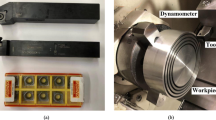Abstract
Workpiece and tool are subjected to severe mechanical and thermal loads when turning. These loads cause thermal expansions and mechanically induced deflections of the tool and the workpiece. Such deformations induce deviations from the nominal workpiece geometry. In order to decrease these deviations, the cutting condition needs to be optimized prior to actual machining. In this paper, the accuracy of machining when dry turning aluminum is analyzed via experiments and finite element simulations. For this purpose, seven characteristic values were used: the forces, the deflection of the workpiece, the quantity of heat in the workpiece, the temperature distribution in the workpiece, the temperature of the tool, the temperature of the tool holder, and the actual dimension of the workpiece after turning. These experimentally determined results serve in addition as boundary conditions for a 3D finite element model of the workpiece, which calculates the deformations of the workpiece. The continuous removal of material affecting the temperature distribution in the workpiece is considered. The actual dimensions of the workpiece after turning revealed a remarkable influence of the cutting condition used on the accuracy of machining. Differences of up to 116 μm regarding the deviation from the nominal workpiece diameter of 30 mm were observed. The analysis of the machining accuracy reveals that particularly the use of both high cutting speeds and feeds enhances the accuracy of machining when dry turning aluminum.










Similar content being viewed by others
References
Koch K-F (1996) Technologie des Hochpräzisions-Hartdrehens. Dissertation, University of Aachen
Moriwaki T, Horiuchi A, Okuda K (1990) Effect of cutting heat on machining accuracy in ultra-precision diamond turning. CIRP Ann Manuf Technol 39(1):81–84
Loehe J, Zaeh MF, Roesch O (2012) In-process deformation measurement of thin-walled workpieces. Procedia CIRP 1:563–568
Klocke F, König W, Lung D, Gerschwiler K (1995) Trocken zerspanen. VDI-Z Integr Prod 137(3/4):38–42
Pabst R (2008) Mathematische Modellierung der Wärmestromdichte zur Simulation des thermischen Bauteilverhaltens bei der Trockenbearbeitung. Dissertation, University of Karlsruhe
Fleischer J, Pabst R, Kelemen S (2007) Heat flow simulation for dry machining of power train castings. CIRP Ann Manuf Technol 56(1):117–122
Klocke F, Eisenblätter G (1997) Dry cutting. CIRP Ann Manuf Technol 46(2):519–526
Bryan J (1990) International status of thermal error research. CIRP Ann Manuf Technol 39(2):645–656
Nicolai M, Hegler R (1980) Werkstücktemperatureinfluss beim Drehen. VDI-Z Integr Prod 6:225–228
Stephenson D, Barone M, Dargush G (1995) Thermal expansion of the workpiece in turning. Trans ASME J Eng Ind 117(4):542–550
Sölter J, Gulpak M (2012) Heat portioning in dry milling of steel. CIRP Ann Manuf Technol 61(1):87–90
Heisel U, Storchak M, Eberhard P, Gaugele T (2011) Experimental studies for verification of thermal effects in cutting. Prod Eng Res Devel 5:507–515
Biermann D, Iovkov I (2013) Modeling and simulation of heat input in deep-hole drilling with twist drills and MQL. Procedia CIRP 8:87–92
Bono M, Ni J (2001) The effects of thermal distortions on the diameter and cylindricity of dry drilled holes. Int J Mach Tools Manuf 41(15):2261–2270
Tai BL, Jessop AJ, Stephenson DA, Shih AJ (2012) Workpiece thermal distortion in minimum quantity lubrication deep hole drilling—finite element modeling and experimental validation. J Manuf Sci Eng 134(1):1–9
Denkena B, Schmidt A, Henjes J, Niederwestberg D, Niebuhr C (2013) Modeling a thermomechanical NC-simulation. Procedia CIRP 8:69–74
Denkena B, Schmidt C, Krüger M (2011) Experimental investigation and modeling of thermal and mechanical influences on shape deviations in machining structural parts. Int J Mach Tools Manuf 50(11):1015–1021
Sukaylo V, Kaldos A, Pieper H-J, Bana V, Sobczyk M (2005) Numerical simulation of thermally induced workpiece deformation in turning when using various cutting fluid applications. J Mater Process Technol 167(2–3):408–414
Zhou JM, Anderson M, Stahl JE (2004) Identification of cutting errors in precision hard turning process. J Mater Process Technol 153–154:746–750
Klocke F, Lung D, Puls H (2013) FEM-modelling of the thermal workpiece deformation in dry turning. Procedia CIRP 8:239–244
Mayer J, Phan A-V, Cloutier G (2000) Prediction of diameter errors in bar turning: a computationally effective model. Appl Math Model 24(12):943–956
Benardos PG, Mosialos S, Vosniakos GC (2006) Prediction of workpiece elastic deflections under cutting forces in turning. Robot Comput Integr Manuf 22(5–6):505–514
Schindler S, Zimmermann M, Aurich JC, Steinmann P (2013) Modeling deformations of the workpiece and removal of material when turning. Procedia CIRP 8:39–44
Dyck M (2007) Beitrag zur Analyse thermisch bedingter Werkstückdeformationen in Trockenbearbeitungsprozessen. Dissertation, University of Karlsruhe
Brecher C, Wissmann A (2011) Compensation of thermo-dependent machine tool deformations due to spindle load: investigation of the optimal transfer function in consideration of rough machining. Prod Eng Res Dev 5:565–574
Weck M, McKeown P, Bonse R, Herbst U (1995) Reduction and compensation of thermal errors in machine tools. CIRP Ann Manuf Technol 44(2):589–598
Acknowledgments
The authors would like to thank the German research foundation (DFG) for funding the project “Thermal effects when turning Al-MMC - experiments and simulations AU 185/26, STE 544/42” within the priority program SPP 1480.
Author information
Authors and Affiliations
Corresponding author
Rights and permissions
About this article
Cite this article
Aurich, J.C., Zimmermann, M., Schindler, S. et al. Analysis of the machining accuracy when dry turning via experiments and finite element simulations. Prod. Eng. Res. Devel. 8, 41–50 (2014). https://doi.org/10.1007/s11740-013-0508-9
Received:
Accepted:
Published:
Issue Date:
DOI: https://doi.org/10.1007/s11740-013-0508-9




